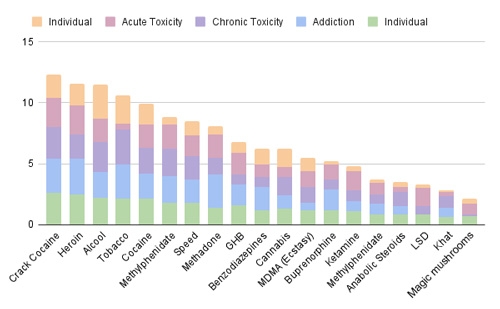
Society has a view on cannabis. It is said to be addictive, unhealthy and crime rates will skyrocket if we make cannabis legal. But if we look at the drugs we all know and accept; coffee, tobacco and alcohol? Are these and other legal mind-altering substances as harmless as they have always been advertised? In this series of articles we will put down objective facts about the drugs that society and media consider normal. Not to defend the use of marijuana or other narcotics, but to see what substances such as caffeine and alcohol do to our health and society.
Some substances are so normal that we forget that they do affect your body, brain and life. In this blog series, we talk about the drugs we don't normally talk about and share what it's like to stop using these silent addictions for a while.
In this blog series:
- Soft drugs & Hard drugs
- Is Alcohol really that normal?
- Caffeine, the accepted liquid drug
- This is how addiction & Dopamine works
The Drugs We consider Normal
If you light up a joint in front of your family or at work, nine times out of ten you will be stared at. Drug use is not considered normal. But there are drugs that we accept in our society. Drinking alcohol, for example, is the most normal thing in the world for many people. A drink on a night out takes the inhibitions away and lets you relax. Until recently, tobacco was also advertised everywhere in the Western world. On a birthday, cigarettes were simply placed on the table next to the nuts. We also often forget that the most widely consumed drinks in the world, coffee and tea, affect our consciousness.
Drugs or nutritional supplement?
The word "drugs" describes illegal, mind-altering substances. There is so much to unwrap within this little phrase that we can't actually explain brieflywhat drugs are. Even government agencies have difficulty doing so. It also doesn't help that there is quite a bit of stretch in the term.
Consciousness
The way you interpret the world can be seen as a part of your consciousness. It involves much more than that, but let's not make it too corny. Not only the well-known drugs like weed, coke and XTC change your consciousness. A cup of tea does affect it as well. So do chocolate and sugar. Some plants or plant extracts cause only subtle, temporary changes in your body and brain. Others cause more drastic modifications in sensory perception.
Not only external factors can affect your consciousness. Stress and even sleep have been known to produce huge changes in your consciousness. Some actions that you can learn are even aimed at altering your consciousness to such an extent that it begins to resemble taking drugs. Often the goal is to teach changes in behavior or to adopt a healthier lifestyle. Yoga is a good example of this, but also the practice of transcendental meditation, the Wim Hof method and holotropic breathing work can in special cases produce visual effects that are very similar to taking psychedelics such as DMT.

Legality
The substances that are referred to as "drugs" are not legal. Even that is not so black or white. In the Netherlands, for example, we have the policy of tolerance, which means that the possession of small amounts of weed, for example, is not criminally prosecuted. Nevertheless, weed is not legal in our country; a common mistake made by tourists. In addition, there is a difference in soft and hard drugs that we explain further on in the article. Now that we have a loose definition of what drugs are, we can move on.
Cultural Differences
Which mind-altering drugs are allowed depends quite a bit on where you grow up or live. This has to do not only with legislation, but also with culture and religion. In Iran, do not drink in public. Alcohol is strictly forbidden there, as it is in many other Islamic countries. There have been impositions in the past in various countries. Perhaps the most famous is the American prohibition from the 1920s. Its purpose was to ban alcohol use and addiction.
In other countries such as Sweden, Turkey and Arabia (before it was called Saudi Arabia), coffee was banned for a while. Now we see that all drinks containing caffeine are legal almost everywhere in the world. Last but not least, indoor smoking is also no longer allowed in most countries. In Malaysia, Uruguay and Colombia, for example, smoking is even more restricted. Bhutan, by the way, is the first country in the world to ban smoking altogether. It is expected that it is only a matter of time before this will happen in other countries as well.
So the types of drugs we consider to be normal depend on the occasion, geographic location, time and societal norms, values and laws in effect.

Natural products such as tobacco, kratom, khat and also marijuana were more tolerated in the world throughout history than they are today. Sometimes legality and acceptance of narcotics have to do with progressive knowledge. If we learn that a certain substance has a high addictive potential, or that it causes more damage to your body and environment than was first thought, we adapt the law accordingly.
The War on Drugs
Science, unfortunately, is not the only factor of decision when we talk about drugs. Gut feelings also come into play. In 1971, then-U.S. President Richard Nixon declared war. Not against another country, but against an often invisible enemy: drugs (and Timothy Leary). The billions that were involved in the illegal trade and the streets packed with spaced-out hippies were no longer acceptable. With military support, the drug trade was controlled not only in America. Other countries followed its lead. It wasn't long before international agreements were made about the use of and trade in mind-altering drugs. Well, not quite. The foundation of those agreements was made in the early 20th century.

Drugs we are slowly becoming comfortable with
Nowadays, we are seeing a shift in global drug policy. Progressive understanding, therefore, does not always mean restriction of drugs. In fact, several countries are in a state of legalization and normalization of soft drugs. Cannabis is undoubtedly the frontrunner. Assisted by facts from medical science and the insight that legalization of cannabis can lead to richer government treasury, the use of weed is now gradually being seen as normal.
So, weed is a gateway drug in a different way than we first thought. It is not so much a stepping stone to the use of other drugs, but normalization of weed does open the gateway to serious research into other plants, mushrooms and designer drugs. Take magic mushrooms and Ecstasy, for example. As the active ingredients psilocybin, ketamine and MDMA are currently being investigated for use in psychiatry, these substances may also suddenly become as normal as prescription anti-depressants. They should be, because chewing mushrooms while clinically depressed is not the way to go. The administration of psilocybin as well as MDMA and ketamine is done under the strictest conditions and only under the supervision of a psychiatrist and/or a trained tripsitter.

Types of Drugs
Our point is that the laws surrounding drugs are quite flexible. On the one hand, we can see that the drugs we used to think were normal are less in favour with science than the drugs we first fought a war against. What is the reason for this? What are the effects of coffee, alcohol and also the body's own dopamine on us and our environment? Are those effects similar to the effects of illegal drugs? In some of the next blogs in this series, we will continue to cover the drugs that we now consider normal.
Tobacco, however, we will not go into further detail. The fact that smoking is unhealthy needs no further explanation. Globally, about 5 million people die each year from the effects of smoking. Lung cancer, COPD and heart disease are the most common direct causes of death among smokers. Smoking is addictive and unhealthy for both the smoker and the environment due to second-hand smoke.
Difference between Soft drugs and Hard drugs
So what is called a "drug" depends on cultural and legal understandings. In countries such as the Netherlands and the United States, drugs are also further classified according to things such as risk of addiction, harmfulness to health and dangers to society. A classification is made between hard drugs (schedule 1 drugs) and soft drugs (schedule 2 controlled substances). But which drugs are classified in which list differs from country to country. Cannabis is called a soft drug in the Netherlands, but in many other countries it is on the list of hard drugs. Basically, soft drugs are less harmful than hard drugs. Oddly enough, alcohol and tobacco are usually not on those kinds of drug lists. Odd? Take a look at the following study.
Research from the Dutch Government (RIVM)
For now, we would like to wrap up this general introduction with a research study by the RIVM (Dutch National Institute for Public Health and the Environment). In order to discuss the harmfulness of drugs, a comparative study is required.
|
Substance |
Acute Toxicity |
Chronic Toxicity |
Addiction |
Social Harm Individual |
Social Harm Population |
Total (summed) |
|
Alcohol |
1.9 |
2.5 |
2.1 |
2.2 |
2.8 |
11.50 |
|
Cannabis |
0.8 |
1.5 |
1.1 |
1.3 |
1.5 |
6.20 |
|
LSD |
1.5 |
0.7 |
0 |
0.8 |
0.3 |
3.30 |
|
Magic mushrooms |
0.9 |
0.1 |
0 |
0.7 |
0.4 |
2.10 |
|
Khat |
0.4 |
0.9 |
0.8 |
0.6 |
0.1 |
2.80 |
|
Tobacco |
0.5 |
2.9 |
2.8 |
2.1 |
2.3 |
10.60 |
|
MDMA (Ecstasy) |
1.3 |
1.3 |
0.6 |
1.2 |
1.1 |
5.50 |
|
Heroin |
2.4 |
2 |
2.9 |
2.5 |
1.8 |
11.60 |
|
Methadone |
1.9 |
1.4 |
2.7 |
1.4 |
0.7 |
8.10 |
|
Speed |
1.7 |
1.9 |
1.9 |
1.8 |
1.2 |
8.50 |
|
Meth |
2 |
2.2 |
2.2 |
1.8 |
0.6 |
8.80 |
|
Cocaine |
1.9 |
2.1 |
2.1 |
2.1 |
1.7 |
9.90 |
|
Crack Cocaine |
2.4 |
2.6 |
2.8 |
2.6 |
1.9 |
12.30 |
|
Methylphenidate (Ritalin) |
0.9 |
0.8 |
0.9 |
0.8 |
0.3 |
3.70 |
|
Benzodiazepines |
1 |
0.8 |
1.9 |
1.2 |
1.3 |
6.20 |
|
Buprenorphine |
1.2 |
0.8 |
1.7 |
1.2 |
0.3 |
5.20 |
|
GHB |
1.8 |
0.8 |
1.7 |
1.6 |
0.9 |
6.80 |
|
Ketamine |
1.6 |
0.9 |
0.8 |
1.1 |
0.4 |
4.80 |
|
Anabolic Steroids |
0.4 |
1.2 |
0.7 |
0.8 |
0.4 |
3.50 |
Acute Toxicity - Damage to the body immediately after ingestion.
Chronic Toxicity - Damage to the body with prolonged use.
Addiction - Chance of addiction.
Social Harm Individual - Do they provoke, for example, aggression, decreased physical or mental control? Is there control over composition?
Social Harm Population - Does someone else's use of the drug harm others?
Total (summed) - The score of insecurity. The higher the number, the more harmful the substance.

Summary
If we examine the aforementioned data and add up all the factors, we see that both alcohol and tobacco have been found to be more harmful than coke and meth (!) by 19 experts with various specializations. Doctors, scientists and addiction experts for example. Not only the Dutch government supports this research. This assessment also includes the findings of a similar British study. Cannabis and MDMA are also close to each other and towards the less harmful half. It is notable that both LSD and magic mushrooms are not addictive according to the study. By using these and some other psychedelics you build up a physical tolerance.Also, tripping is totally not the same as being nice and high or drunk. It is quite an undertaking for your brain to process such an experience. As a result, you don't immediately feel the need to do it again within a short period of time.
Next article in the blog series: Alcohol
Sources:
RIVM Drug ranking: https://www.rivm.nl/bibliotheek/rapporten/340001001.pdf